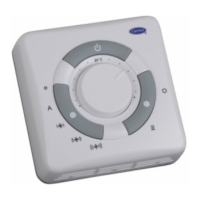PG80VTLA: Installation, Start-up, Operating and Service and Maintenance Instructions
Manufacturer reserves the right to change, at any time, specifications and designs without notice and without obligations.
36
* Orifice numbers 43 are factory installed
Check Safety Controls
The flame sensor, gas valve, and pressure switch were all checked in the
Start-up procedure section as part of normal operation.
1. Check Main Limit Switch
This control shuts off combustion system and energizes
air-circulating blower motor, if furnace overheats. By using this
method to check limit control, it can be established that limit is
functioning properly and will operate if there is a restricted
return-air supply or motor failure. If limit control does not function
during this test, cause must be determined and corrected.
a. Run furnace for at least 5 minutes.
b. Gradually block off return air with a piece of cardboard or sheet
metal until the limit trips.
c. Unblock return air to permit normal circulation.
d. Burners will re-light when furnace cools down.
2. Check draft safeguard switch. The purpose of this control is to
cause the safe shutdown of the furnace during certain blocked vent
conditions.
a. Verify vent pipe is cool to the touch.
b. Disconnect power to furnace and remove vent connector from
furnace vent elbow.
c. Restore power to furnace and set room thermostat above room
temperature.
d. After normal start-up, allow furnace to operate for 2 minutes,
then block vent elbow in furnace 80 percent of vent area with a
piece of flat sheet metal.
e. Furnace should cycle off within 2 minutes. If gas does not shut
off within 2 minutes, determine reason draft safeguard switch did
not function properly and correct condition.
f. Remove blockage from furnace vent elbow.
g. Switch will auto-reset when it cools.
h. Re-install vent connector.
NOTE: Should switch remain open longer than 3 minutes, furnace
control board will lockout the furnace for 3 hours. To reset furnace
control board, turn thermostat below room temperature or from HEAT to
OFF and turn 115-v power OFF, then back ON.
3. Check Pressure Switch(es)
This control proves operation of the draft inducer blower.
a. Turn off 115-v power to furnace.
b. Disconnect inducer motor lead wires from wire harness.
c. Turn on 115-v power to furnace.
d. Set thermostat to “call for heat” and wait 1 minute. When
pressure switch is functioning properly, hot surface igniter
should NOT glow and control diagnostic light flashes a status
code 32. If hot surface igniter glows when inducer motor is
disconnected, shut down furnace immediately.
e. Determine reason pressure switch did not function properly and
correct condition.
f. Turn off 115-v power to furnace.
g. Reconnect inducer motor wires, replace outer door, and turn on
115-v power.
h. Blower will run for 90 seconds before beginning the call for heat
again.
i. Furnace should ignite normally.
Checklist
1. Put away tools and instruments. Clean up debris.
2. Verify that switches SW1-1 and SW1-6 are OFF and other setup
switches are set as desired. Verify that switches SW1-7 and SW1-8
for the blower OFF DELAY are set as desired per Table 10.
3. Verify that blower and burner access doors are properly installed.
4. Cycle test furnace with room thermostat.
5. Check operation of accessories per manufacturer’s instructions.
6. Review User’s Guide with owner.
7. Attach literature packet to furnace.
ALTITUDE RANGE
FT. (M)
AVG. GAS HEAT
VALUE AT
ALTITUDE
(BTUH/CU FT.)
SPECIFIC GRAVITY OF NATURAL GAS
0.58 0.60 0.62 0.64
Orifice No.
Manifold
Pressure
High/Low
Manifold
Pressure
High/Low
Orifice No.
Orifice No.
Manifold
Pressure
High/Low
Orifice No.
Manifold
Pressure
High/Low
USA
7001 to
8000 (2134
to 2438)
650 44 3.6/1.6 43 3.2/1.4 43 3.4/1.5 43 3.5/1.5
675 44 3.3/1.5 44 3.5/1.5 44 3.6/1.6 43 3.2/1.4
700 45 3.8/1.6 44 3.2/1.4 44 3.3/1.4 44 3.4/1.5
725 46 3.7/1.6 46 3.8/1.7 45 3.7/1.6 44 3.2/1.4
750 46 3.4/1.5 46 3.6/1.5 46 3.7/1.6 46 3.8/1.6
775 47 3.6/1.6 47 3.8/1.6 46 3.4/1.5 46 3.6/1.5
800 47 3.4/1.5 47 3.5/1.5 47 3.7/1.6 47 3.8/1.6
825 48 3.7/1.6 48 3.8/1.6 47 3.4/1.5 47 3.6/1.5
USA
8001 to
9000
(2438 to
2743)
625 44 3.3/1.5 44 3.5/1.5 44 3.6/1.6 43 3.2/1.4
650 45 3.7/1.6 44 3.2/1.4 44 3.3/1.4 44 3.4/1.5
675 46 3.6/1.6 46 3.8/1.6 45 3.7/1.6 45 3.8/1.7
700 47 3.8/1.7 46 3.5/1.5 46 3.6/1.6 46 3.7/1.6
725 47 3.6/1.6 47 3.7/1.6 47 3.8/1.7 46 3.5/1.5
750 48 3.8/1.7 47 3.5/1.5 47 3.6/1.6 47 3.7/1.6
775 48 3.6/1.5 48 3.7/1.6 48 3.8/1.7 47 3.5/1.5
USA
9001 to
10,000
2743 to
3048)
600 45 3.7/1.6 45 3.8/1.7 44 3.3/1.4 44 3.4/1.5
625 46 3.6/1.6 46 3.7/1.6 46 3.8/1.7 45 3.8/1.6
650 47 3.8/1.6 46 3.4/1.5 46 3.6/1.5 46 3.7/1.6
675 47 3.5/1.5 47 3.6/1.6 47 3.7/1.6 46 3.4/1.5
700 48 3.7/1.6 48 3.8/1.7 47 3.5/1.5 47 3.6/1.6
725 48 3.5/1.5 48 3.6/1.6 48 3.7/1.6 48 3.8/1.7
Table 12 – Orifice Size and Manifold Pressure (In. W.C.) for Gas Input Rate (Tabulated Data Based on 22,000 Btuh High-Heat/14,500 Btuh
for Low-Heat per Burner, Derated 4 Percent for Each 1000 Ft.(305 M) Above Sea Level) (Continued)

